The crossover SUV craze is in full swing in America and three vehicles are at the center of it. Toyota RAV4 has emerged as the hottest SUV and remains best seller for many years followed by Honda CR-V and Nissan Rogue.
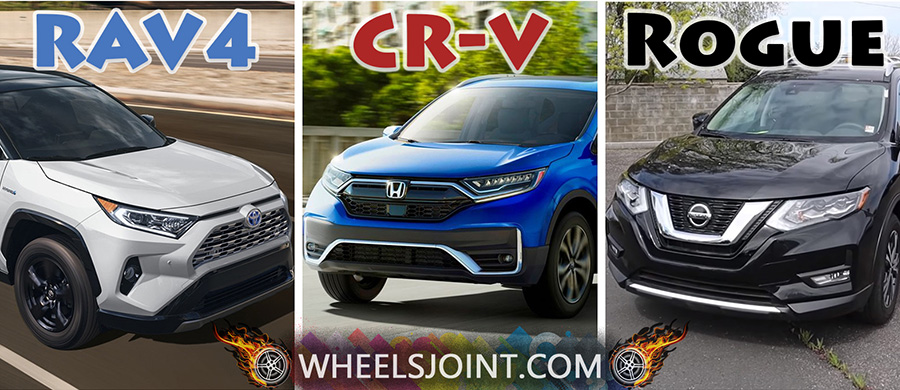
Variants
Toyota RAV4 is offered in 10 variants with LE as base model and Limited edition as top of the line, powered by 2.5 liter four cylinder engine. All wheel drive powertrain is available in LE, XLE and XLE Premium, and comes standard on Adventure and all hybrid trims. Additionally, a new plug-in hybrid version is expected to hit the showroom floors by mid 2020.
Honda CR-V is assembled in four models namely LX, EX, EX-L and Touring, powered by 1.5 liter in-line four cylinder engine with turbocharger. All wheel drive system is available as an optional feature in all variants. Its hybrid version is expected to hit production by mid 2020.
Nissan Rogue and its smaller sibling Rogue Sport are available in three trims S, SV and SL with AWD as an optional feature, powered by 2.5 liter and 2.0 liter four cylinder engine respectively.
Fuel Economy
RAV4 Hybrid boasts stellar combined fuel economy of 40 mpg that is 33 percent higher than Honda CRV’s 30 mpg and 43 percent higher as compared to Nissan Rogue.

Driving Range
RAV4 Hybrid again leads by a significant margin, offering 580 miles of range with its 14.5 gallon fuel tank. Honda CR-V with 14 gallon tank will take you as far as 420 miles while Rogue lags behind with 406 miles of range with its 14.5 gallon tank. These figures are based on combined fuel consumption for city and highway driving.

Horsepower
Another win for RAV4 Hybrid, offering stunning 219 hp that is notably better than its rival CR-V’s 190 horsepower @ 5,600 rpm. Nissan Rogue again finished last with 170 hp @ 6,000 rpm for its standard version and scanty 141 hp for sport version.
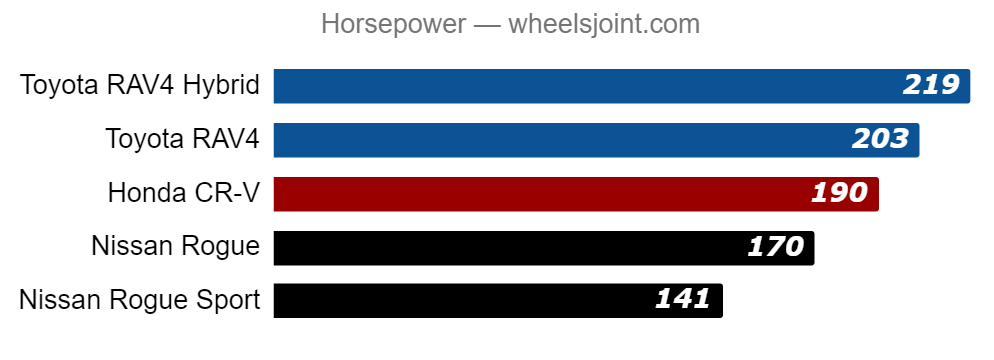
Torque
Yet again RAV4 is leading the pack with 184 pound feet of torque and yet again Rogue came at last with 147 lb-ft @ 4,400 rpm.

Acceleration
Since the automakers do not specify acceleration figures officially, we will have to rely on third party test results for this comparison. RAV4 is quickest of all and does naught to sixty miles per hour in 7.4 seconds according to Car and Driver, Honda CR-V does 0-60 mph in 7.5 seconds as per the tests done by Edmunds. Nissan Rogue is painfully slow, doing 0-60 mph in wearisome 14.7 seconds according to TFLcar, while its sport version is marginally faster at 10 seconds. The upcoming RAV4 Prime is much nippier with 0-60 mph in 5.8 seconds according to Toyota, but its not included because of its unavailability at this time.

Towing Capacity
RAV4 Adventure grade can tow up to 3,500 pounds that is double the towing capability of hybrid version. Standard RAV4 grades and Honda CR-V have the ability to tow up to 1,500 lbs. Rogue is the least capable vehicle with towing limit of only 1,102 lbs.

Ground Clearance
Toyota RAV4 XLE Premium, Adventure and Limited grades offer the highest ground clearance of 8.6 inches among its competition.
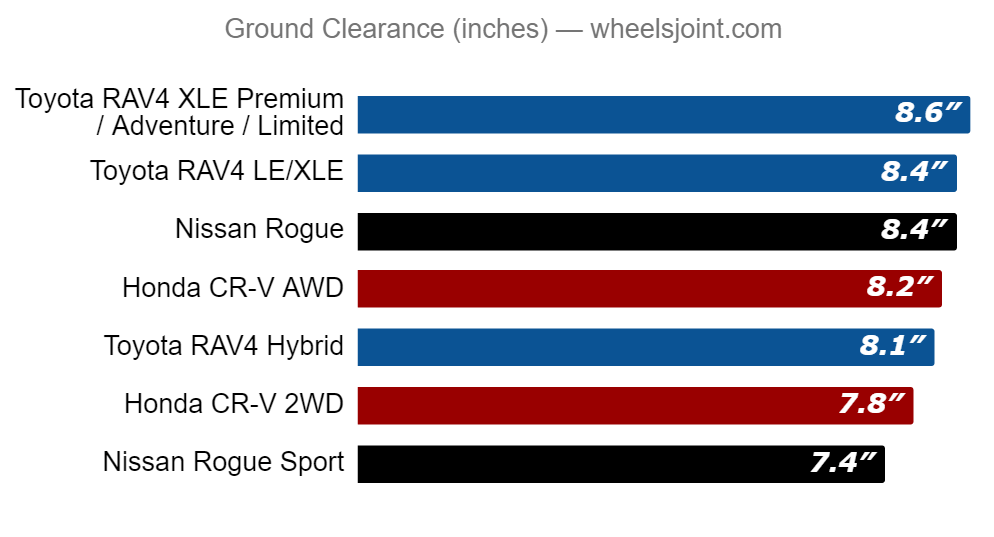
Cargo Capacity
There isn’t much difference in terms of cargo volume with rear seats up, about 39 cubic feet, except Rogue Sport with just 23 cu. ft. of cargo space.

With rear seats down CR-V shines above its competition with 76 cubic feet of luggage space.

Exterior Dimensions
Nissan Rogue is the longest vehicle with 184.5 inch length and its sport version is shortest at 172.8 inches.

RAV4 and CR-V are of exactly the same width at 73 inches, while Rogue is a little narrower at 72.4 inches.

Rogue vehicle height is 68.5 inches for its four wheel drive version, higher than all others. This might look like a positive aspect, but its a taller, longer, but narrower SUV, which is not ideal for cornering traction on the road due to poor center of gravity.

Curb Weight
Honda CR-V base model is lightest among all with 3,337 lbs of unladen weight for its base model, while RAV4 Hybrid Limited is the heaviest at 3,800 lbs.
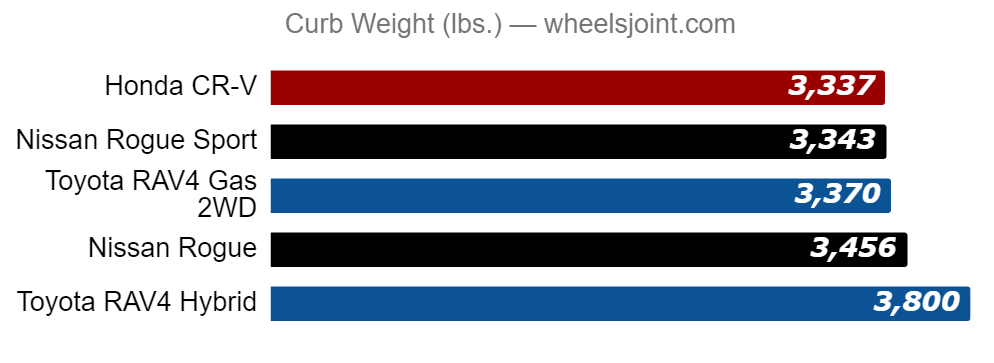
Price
The most economical vehicle among all is Nissan Rogue Sport S at $23,240 (US dollars), but you get a lot less than its regular counterpart that is priced at $25,300. Honda CR-V LX is certainly best priced at $25,050 that is $800 less than base model of RAV4.
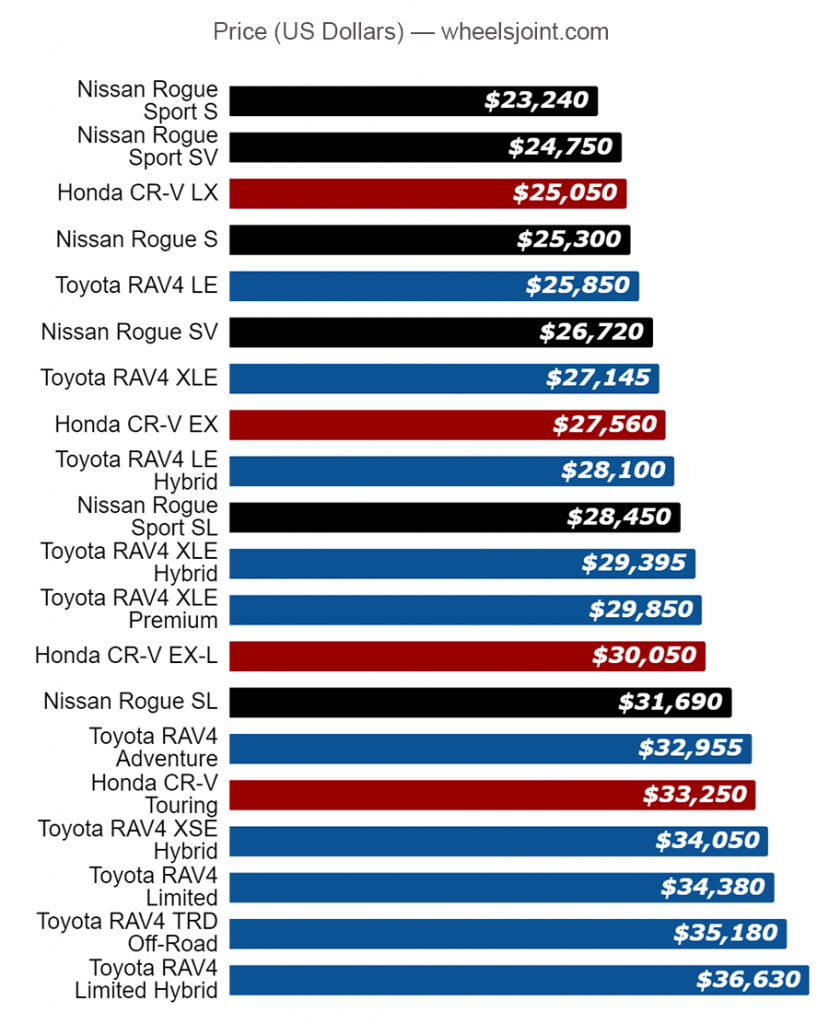
Interior
Toyota RAV4 can fit five passengers and comes standard with cloth upholstery, manual seats, 7 inch infotainment system touch screen with Android Auto, Apple CarPlay and integrated Amazon Alexa. Its contemporary interior is made with good quality materials.
Honda CR-V has an attractive cabin made with good quality materials. The base variant is a little deficient in features though. It has one of the most spacious cabins in the class, with plenty of of head and legroom. It comes standard with 5 inch screen in the middle which can be upgraded to 7 inch touch screen featuring Android Auto, Apple CarPlay and built-in navigation.
Nissan Rogue interior looks dated compared to other two but does offer many safety and tech features as standard, like 7 inch touch screen with Android Auto and Apple CarPlay, rear-view camera, etc.

Vehicle Popularity
Throughout its life, Honda CR-V remained best selling SUV in America, but that is no longer true since 2017 when it was succeeded to the throne by Toyota RAV4 and still remains the most popular SUV with 448,068 sales in 2019, up 5 percent from previous year. Nissan Rogue also remained trendy SUV and witnessed continuous growth for 12 years, but in 2019 its sales dropping a massive 15 percent in a growing crossover market.

Driver Assistance
Toyota RAV4 features Toyota Safety Sense™, a standard feature on all its models. The system includes pre-collision automatic braking, lane departure warning with the ability of auto steering to keep vehicle in lane, auto high beam, road sign detection and adaptive cruise control.
Honda CR-V comes standard with Honda Sensing which features adaptive cruise control with low speed follow and lane assist. Other features include collision mitigation braking system, lane departure warning, blind spot monitor.
Nissan Rogue comes with ProPILOT Assist in its top of the line SL variant which enables semi-autonomous driving on highways. It features radar-based cruise control for following traffic and camera-based auto steering that keeps the vehicle in center of lane.
Hybrid technology comparison RAV4 vs CR-V
You can hardly believe it: until recently, the compact SUVs of the hybrid pioneers Honda and Toyota had to do without an additional electric drive. Which streams skilful, CR-V or RAV4?
It’s been 20 years since the first large-series hybrid cars came onto the market: Toyota Prius and Honda Insight. It is all the more surprising that the two brands have recently put their high-volume compact SUV under power – and at the same time have dispensed with diesel engines. The Honda is otherwise only available with a 173 or 193 hp 1.5 liter, the Toyota with a two liter petrol engine with 175 hp, each with front or four-wheel drive.
From this point of view, the hybrid versions seem to be good alternatives, especially since the surcharges for the additional electric drives and energy storage are limited. It is $3,000 for the RAV4 and about $4,000 in the case of the CR-V – actually good deals, considering the effort involved in the complex drive. The two SUVs are not exactly cheap, because the Toyota costs at least $28,100 as a hybrid and even $36,630 for top of the line Limited edition.
The two manufacturers go very different paths in hybrid technology. So the Honda is a so-called mixed hybrid that mostly drives electrically. The petrol engine only charges the Li-ion battery and only drives the front wheels with a fixed gear ratio in certain driving conditions and at higher speeds. The well-known power-split hybrid drive with two motor generators, a planetary gear – known as a power split device – as well as a four-cylinder petrol engine and a nickel-MH battery pack are used in the Toyota.
The driving impression is shaped by the continuously variable transmission – a very special Toyota hybrid feeling that has hardly changed in the past 20 years despite the further development. In contrast, the performance level has changed, because the 2.5 VVT-i combined with the electric motor has a system output of 218 hp. The RAV4 accelerates from stationary to 100 km/h in 7.4 seconds, and can accelerate from 60 to 100 km/h in 4.5 seconds. So it is respectable, only the four-cylinder engine, which is rather reluctantly howling, suggests a lack of willingness to perform. So the Toyota looks tougher than it is according to the measured values.
So the Honda looks a lot more dynamic, also because it comes more agile around the corner – if you can say that in this comparison. Both are not exactly known as curve artists, they are too sluggish and too diffuse in their driving behavior. The fact that the CR-V feels a little more lively is partly due to the more precise steering. Surprisingly, the RAV4 dances a little faster, but only if you drive sensitively enough not to be slowed down by the overzealous intervention in the stability program.
But – the real life of a hybrid SUV consists only in small parts of exuberant cornering fun. Practical questions are much more often in the foreground, including those relating to transport capacity and passenger comfort.
In these disciplines, Toyota and Honda are fairly close together, and if you spend a few quiet days with either of them, you better understand why they are among the best-selling compact SUVs in the world. Both are cars of the type that leave you alone and do their job inconspicuously without requiring much attention. And of course four adults and their luggage are both well accommodated – with slight advantages for the Honda: Its interior is a few millimeters wider at the rear and the front, and you can tell that too.
The RAV4 has a reclining backrest that contributes to the well-being of the rear passengers. On the other hand, they can look forward to better suspension comfort in the CR-V. The ironed over bumps a little smoother, although it should be noted that neither of the two SUVs is convincingly coordinated. They roll over transverse joints without being planed, in the case of coarse bumps, the Honda is more confident and has greater travel reserves. In contrast, the RAV4 looks inharmonious – with tight springs and rumbling breakaway torque.
The Toyota gets the crucial points for the final settlement with the security. It decelerates a lot better, only at full braking from 130 km/h does the Honda come to a stop earlier. And the Toyota comes with a somewhat more extensive security package, both of which are very well equipped.
For example, the RAV4 has an additional knee airbag for the driver as standard, automatic emergency calls, pre-collision warner with bicycle and traffic sign recognition and lane assistants. In the CR-V there are also the usual helpers such as fatigue warning, cruise control, active lane keepers and collision warning as standard, if you choose the elegance equipment.
In the case of the lane assistant, however, this is not an unadulterated pleasure, because it annoys with premature warning including steering wheel vibrations. Another small point that helps the Honda to finish just behind the Toyota in this comparison test.









